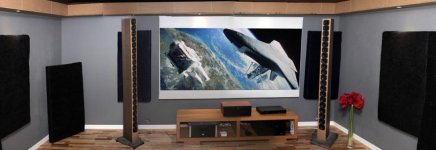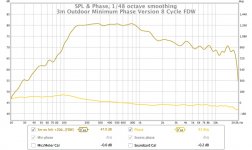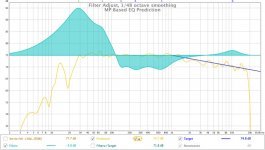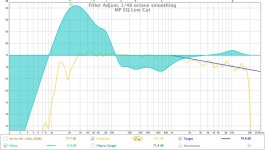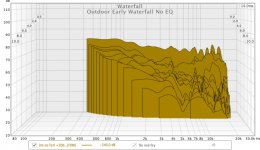Great build Fluid - hope you will enjoy them soon!
Single vs two arrays in action = massive difference
As for absorption panels such beasts can easily be altered to please the other half with some creative patterns/print etc. In my room I also use absorption behind the acustic transparent projection screen
Single vs two arrays in action = massive difference
As for absorption panels such beasts can easily be altered to please the other half with some creative patterns/print etc. In my room I also use absorption behind the acustic transparent projection screen
Attachments
I honestly believe for woofers to get damaged, you need more than two, series connected, in a smallish sealed container. It's like a tug of war game but with 5 drivers working in tandem. If a driver gets out of phase for any reason, three or four or five drivers working against it will rip it to shreds.
This damage scenario would be impossible if each driver had it's own sealed enclosure because I strongly believe the backwave pressure from three or more drivers loaded very close to xmech would easily overpower and catastrophically blow the remaining cone. Series is tug of war with a single large load and everyone sharing the same rope. Parallel is tug of war with everyone pulling a separate rope connected to a single large load. And a sealed off enclosure for every driver in either configuration would be like five horses pulling five small carts, each isolated from the others.
A distinction needs to be made clear between different types of drivers. Sub drivers that could be expected to be driven hard with significant excursion and therefore significant amounts of air being displaced are far different to an array of much smaller drivers.
Owen has given an example of almost the worst case scenario. There are many variations in between.
Any bunch of drivers used close to xmech are likely to fail. Xmech is the damage point and most drivers don't come back from that.
Whilst the discussion has been interesting and enlightening I don't see anything that makes me worry for my drivers. The most likely scenario seems to be an increase in distortion at higher levels.
If anyone has any data (rather than opinion) to present like OP's distortion measurements (when he gets the chance to take them) I'm all for it.
Great build Fluid - hope you will enjoy them soon!
Single vs two arrays in action = massive difference
As for absorption panels such beasts can easily be altered to please the other half with some creative patterns/print etc. In my room I also use absorption behind the acustic transparent projection screen
Thanks Halair, I am keen to hear two in stereo
Pleasing the other half isn't really my issue, I don't want to waste time and effort to build something that won't fit well in the room these are likely to end up in long term. I also don't need to use any new materials as I will have to have them moved across the country when we move which is not going to be that far away in time (not in distance). I do have some spare fibreglass, felt, acrylic material and wood so I may use that in some fashion to make a poster panel
I was reading through the convolution thread today where gmad was talking about using a minimum phase version of a measurement with a 4 to 8 cycle FDW to base a speaker correction on.
I decided to test it out virtually in REW with an outdoor measurement without EQ to see what I would get.
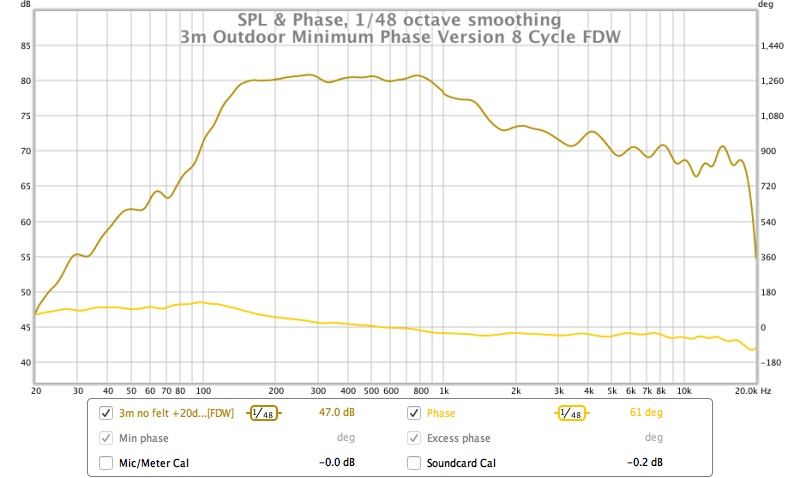
A bit of gentle EQ (apart from the bass boost) and the result looks pretty good for only 6 PEQ's. I should probably add in some cut below 20Hz as the Q of the bass boost was broad. I think I will give this a listen when I get back and it might make a reasonable pre EQ as a base for DRC to clean it up a bit more. Still has that line array EQ look to it
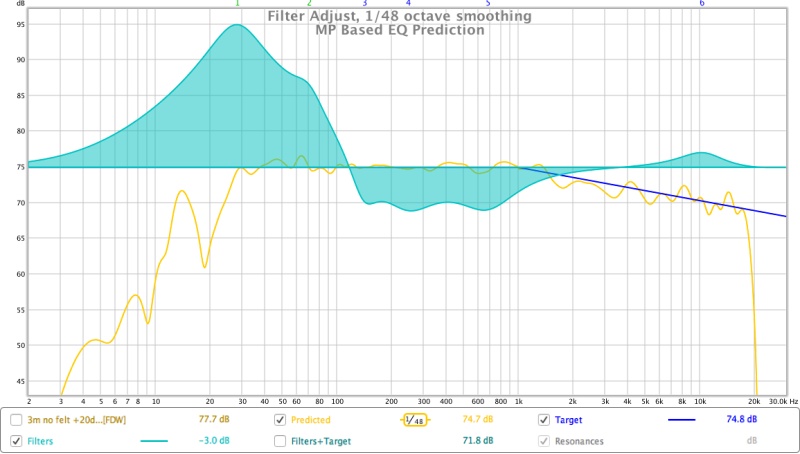
I decided to test it out virtually in REW with an outdoor measurement without EQ to see what I would get.
A bit of gentle EQ (apart from the bass boost) and the result looks pretty good for only 6 PEQ's. I should probably add in some cut below 20Hz as the Q of the bass boost was broad. I think I will give this a listen when I get back and it might make a reasonable pre EQ as a base for DRC to clean it up a bit more. Still has that line array EQ look to it
Attachments
I am following this thread with interest, and I am amazed by line arrays. Maybe one day I build one. In the meantime, I was thinking about series vs parallel driver connection.
There is yet another solution, albeight a bit bizarre, but not impossible:
A separate amplifier for each driver. If there are 50 drivers per channel, that would be 25 stereo amplifiers per channel, or, well, 50 amps in total. But, before you roll your eyes in disgust, let me tell you that I have built some small D class amps 2x3 w, Pam 8403, which sounds surprisingly good for what it is and for its almost ridiculous price (10 stereo boards cost about 2.35 bucks). So the price of 50 boards for this line array would be less than 12 bucks (without 5v psu's) .
.
Yep, it is not practical, but hey, drilling 200 holes and tighting 200 screws isn't practical either, but we are not looking for easiness and practicality in this hobby, aren't we?
So, sorry for off-topic but I just had this idea that I wanted to share with you
There is yet another solution, albeight a bit bizarre, but not impossible:
A separate amplifier for each driver. If there are 50 drivers per channel, that would be 25 stereo amplifiers per channel, or, well, 50 amps in total. But, before you roll your eyes in disgust, let me tell you that I have built some small D class amps 2x3 w, Pam 8403, which sounds surprisingly good for what it is and for its almost ridiculous price (10 stereo boards cost about 2.35 bucks). So the price of 50 boards for this line array would be less than 12 bucks (without 5v psu's)
Yep, it is not practical, but hey, drilling 200 holes and tighting 200 screws isn't practical either, but we are not looking for easiness and practicality in this hobby, aren't we?
So, sorry for off-topic but I just had this idea that I wanted to share with you
Your solution would likely be extremely power inefficent and involve a rat's nest of wiring. Stereo amps would reduce the number of circuits needed but 25 small amps driving a few dozen watts combined load is far more inefficient than one large amp driving a few dozen watts of load. Also the outputs of each amp would vary depending on individual volume settings and it would be a nightmare calibrating them to all output on the same level.I am following this thread with interest, and I am amazed by line arrays. Maybe one day I build one. In the meantime, I was thinking about series vs parallel driver connection.
There is yet another solution, albeight a bit bizarre, but not impossible:
A separate amplifier for each driver. If there are 50 drivers per channel, that would be 25 stereo amplifiers per channel, or, well, 50 amps in total. But, before you roll your eyes in disgust, let me tell you that I have built some small D class amps 2x3 w, Pam 8403, which sounds surprisingly good for what it is and for its almost ridiculous price (10 stereo boards cost about 2.35 bucks). So the price of 50 boards for this line array would be less than 12 bucks (without 5v psu's).
Yep, it is not practical, but hey, drilling 200 holes and tighting 200 screws isn't practical either, but we are not looking for easiness and practicality in this hobby, aren't we?
So, sorry for off-topic but I just had this idea that I wanted to share with you
Another option would be to use an audio transformer to impedance match the drivers, though this carries it's own issues. Most audio transformers are only designed to operate at signal levels, not power levels, and a sufficiently large transformer might saturate at bass frequencies resulting in distortion, and the high inductance of the windings will attenuate and phase shift at high frequencies. A power transformer such as a repurposed wall wart designed for 50/60Hz probably wouldn't pass much signal to the secondaries at 10kHz.
For 25 8 ohm drivers in parallel to appear 8 ohms to the amp, you need a winding ratio of 25:1 and would have .32 ohms impedance on the secondary. A 120VAC wall wart that outputs 5VAC on the secondary would have way too much impedance across the primary to be useful.
Either scenario (tons of mini amps or a transformer) to eliminate series drivers would likely be worse sonically than just wiring drivers in series. These small drivers are not going to destroy each other in open chamber like the subwoofer example.
You are right, but we are brave diy-esr and not affraid of rat's nests 
I know it might scare some, but I just thought that it is doable. Imagine if you had the nerves and time to properly route these cables and wires, it could be even housed ouside the main box, on the back, sandwitched between two plexi sheets, it could even be made to look beautiful. Amps could be more powerful of course, like Pam 8610 of around 10w, which works on 12 v (it could be even marine-battery operated)
I know it might scare some, but I just thought that it is doable. Imagine if you had the nerves and time to properly route these cables and wires, it could be even housed ouside the main box, on the back, sandwitched between two plexi sheets, it could even be made to look beautiful. Amps could be more powerful of course, like Pam 8610 of around 10w, which works on 12 v (it could be even marine-battery operated)
There are several D class amps out there, which are cheap and sound decent. I think that 10w per driver would be plenty, above that it gets a bit more expensive and not necessarily better. So, its PAM 8610 chip/board, or more powerful/more expensive (but still cheap) TPA 3116 or similar. Of course you could use other AB class chips, like TDA 7297, or even 50 pieces of LM 3886, but that would be an overkill even for an enthusiast 
A bit of gentle EQ (apart from the bass boost) and the result looks pretty good for only 6 PEQ's. I should probably add in some cut below 20Hz as the Q of the bass boost was broad. I think I will give this a listen when I get back and it might make a reasonable pre EQ as a base for DRC to clean it up a bit more. Still has that line array EQ look to it

I'd advise to bring the average EQ target down a bit (about 5 dB) to reduce the amount of boost needed. Basically get the EQ target more in the middle, more cut at 200-800 Hz, less boost at 30 Hz needed that way.
I am following this thread with interest, and I am amazed by line arrays. Maybe one day I build one. In the meantime, I was thinking about series vs parallel driver connection.
There is yet another solution, albeight a bit bizarre, but not impossible:
A separate amplifier for each driver. If there are 50 drivers per channel, that would be 25 stereo amplifiers per channel, or, well, 50 amps in total. But, before you roll your eyes in disgust, let me tell you that I have built some small D class amps 2x3 w, Pam 8403, which sounds surprisingly good for what it is and for its almost ridiculous price (10 stereo boards cost about 2.35 bucks). So the price of 50 boards for this line array would be less than 12 bucks (without 5v psu's).
Yep, it is not practical, but hey, drilling 200 holes and tighting 200 screws isn't practical either, but we are not looking for easiness and practicality in this hobby, aren't we?
So, sorry for off-topic but I just had this idea that I wanted to share with you
Definitely has crossed my mind a few times. Maybe some day...
I'd advice using at least a 10-15 watt amp for each driver.
It's how the Beolab 90 is wired and opens up a world of new possibilities.
Either scenario (tons of mini amps or a transformer) to eliminate series drivers would likely be worse sonically than just wiring drivers in series. These small drivers are not going to destroy each other in open chamber like the subwoofer example.
I think no one is really worried about destroying drivers in these arrays with the series/parallel wiring. I've been running my arrays for 2.5 years straight without any trouble and they have produced a lot of sound in that period!
The only thing on my mind is a slightly more even load on each driver when I look at the sims. Even raising the overall potential before any single driver hits x-max. It probably is going to be quite a small difference though. I still think it has an advantage and could/would be worth the trouble.
Just a comment on 26 dB boost at 20Hz vs 250 Hz:
Say 9volts at each driver at 30 Hz.
Then the poweramp needs 5x9V = 45V at 30Hz. About what a 400W amp can do.
So how much is delivered at for each driver at 250 Hz?
26 db is 20 times amplified. So 9 volts at 30Hz and 9V/20 = 0.5V at 250Hz
Total 2.5 Volts. So 1 watt. One driver needs about 0.05Watts at 250Hz.
So with 26dB gain, 9 volts at 30Hz is not unrealistic?
Say 9volts at each driver at 30 Hz.
Then the poweramp needs 5x9V = 45V at 30Hz. About what a 400W amp can do.
So how much is delivered at for each driver at 250 Hz?
26 db is 20 times amplified. So 9 volts at 30Hz and 9V/20 = 0.5V at 250Hz
Total 2.5 Volts. So 1 watt. One driver needs about 0.05Watts at 250Hz.
So with 26dB gain, 9 volts at 30Hz is not unrealistic?
...Definitely has crossed my mind a few times. Maybe some day...
I'd advice using at least a 10-15 watt amp for each driver.
It's how the Beolab 90 is wired and opens up a world of new possibilities.
That's why I asked for amp modules in the 20 - 25W range. DC controlled volume would make beam steering (in the volume domain) really easy
Just a comment on 26 dB boost at 20Hz vs 250 Hz:
Say 9volts at each driver at 30 Hz.
Then the poweramp needs 5x9V = 45V at 30Hz. About what a 400W amp can do.
So how much is delivered at for each driver at 250 Hz?
26 db is 20 times amplified. So 9 volts at 30Hz and 9V/20 = 0.5V at 250Hz
Total 2.5 Volts. So 1 watt. One driver needs about 0.05Watts at 250Hz.
So with 26dB gain, 9 volts at 30Hz is not unrealistic?
The above EQ example is based on a free standing outside measurement. In a room we would need (slightly) less boost at low frequencies.
To stay within x-max of the TC9 a theoretical (simmed) maximum of about 240 watt is needed at 30 Hz. Real world level would depend on placement within the room.
Awesome.
Thanks
Not really off topic and you are right line arrays are not simple buildsI am following this thread with interest, and I am amazed by line arrays. Maybe one day I build one. In the meantime, I was thinking about series vs parallel driver connection.
There is yet another solution, albeight a bit bizarre, but not impossible:
A separate amplifier for each driver. If there are 50 drivers per channel, that would be 25 stereo amplifiers per channel, or, well, 50 amps in total. But, before you roll your eyes in disgust, let me tell you that I have built some small D class amps 2x3 w, Pam 8403, which sounds surprisingly good for what it is and for its almost ridiculous price (10 stereo boards cost about 2.35 bucks). So the price of 50 boards for this line array would be less than 12 bucks (without 5v psu's).
Yep, it is not practical, but hey, drilling 200 holes and tighting 200 screws isn't practical either, but we are not looking for easiness and practicality in this hobby, aren't we?
So, sorry for off-topic but I just had this idea that I wanted to share with you
There are a couple of down sides to having so many amps. The worst is the potential for ground loops if you share power supplies. It is not easy to get a large number of amps to run off a shared power supply and avoid hum.
It could also be problematic to have 25 inputs running from the same line level input easy enough to overcome with buffers but then it gets even more complicated.
I can appreciate the idea but I think the parallel series wiring with a single amp is a better overall solution.
There was a guy that posted in wesayso's two towers thread with a curved array where he used only parallel connections. He built 0.5 ohm stable amps and paralleled about 3 or 4 drivers to each amp.
I don't see why the efficiency would change as the load would be the same, 25 x 10W amps should be equivalent to one 250W in that arrangement as long as either can produce that power cleanly. A lot of the mini amps have dreadful distortion when driven anywhere near their rated power. Most are 10% at the power they are rated for. If the amps voltage gain has tight tolerance the sensitivity differences between the drivers themselves is likely greater.Your solution would likely be extremely power inefficent and involve a rat's nest of wiring. Stereo amps would reduce the number of circuits needed but 25 small amps driving a few dozen watts combined load is far more inefficient than one large amp driving a few dozen watts of load. Also the outputs of each amp would vary depending on individual volume settings and it would be a nightmare calibrating them to all output on the same level.
Even good quality line level transformers are very expensive power ones even more so.Another option would be to use an audio transformer to impedance match the drivers, though this carries it's own issues.
The LM3886 amps are very good and compact but the power supply requirements are much more than the class D types.@Vix
Any suggestions for a 20-25W amp?
Wiring wouldn't be so dreadful, as there are only short lengths of speaker wire per speaker, and the rest is line level and power supply.
Word. And you would need a massively heavy gauge secondary winding to drive a .32 ohm load at power.Even good quality line level transformers are very expensive power ones even more so.
I'd advise to bring the average EQ target down a bit (about 5 dB) to reduce the amount of boost needed. Basically get the EQ target more in the middle, more cut at 200-800 Hz, less boost at 30 Hz needed that way.
Agreed, my method for that is to apply -5dB attenuation (or whatever amount is desired) at the input
I picked that target level because it made the EQ simpler.
If I use the Najda I need to run practical tests to check for headroom and adjust accordingly. With the rough EQ I had 24dB of boost in the filters but -12 dB input attenuation to avoid clipping
Jriver might be different as I think it has more digital headroom.
Hi fluid as far as i know waterfall plot don't care and react to setting any FDW so must be based on raw IR but it has its own presenting possibility in setting smoothing numbers within 1/3-1/48. Think some of wesayso's points is its easy to EQ first ridge smooth and flat to whatever target one prefer, problem is next ridges will start show resonances that get much worse than before EQ correction if EQ is based on any interference/reflections. When EQ is based on windowed measurements and those windows settings are optimized for actual in situation not only into windowed curves things start look good but also raw windows start to look good including waterfall.
- Home
- Loudspeakers
- Full Range
- Full Range TC9 Line Array CNC Cabinet
